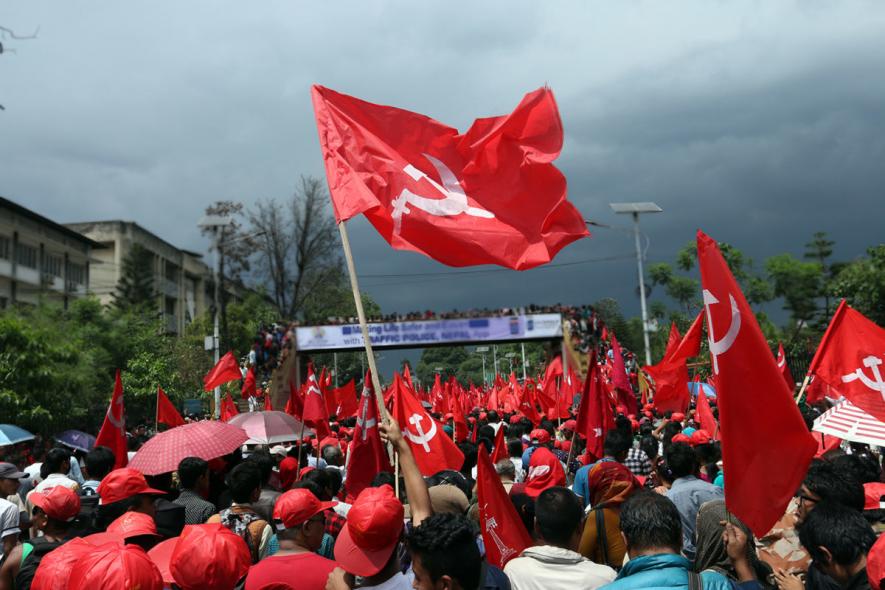Nepal's Journey Towards Socialism

The Journey towards peoples' socialism is never easy and a difficult one to sustain as we have seen in many Socialist states established by the revolt of the working class. At the present juncture, when the globalized world is dominated by politico-economy of capitalism and there is an increasingly right-wing assurgence, the bourgeoisie in its objective of monopolising the global resources, has replaced the left government in Brazil, Ecuador and Argentina, and seriously challenging others such as Venezuela and Bolivia.
Amidst the increasing challenges for the left movement, the people of Nepal passionately supported the left forces, giving them around two-third majority in the recent elections in the Himalayan nation. Their confidence in the left movement is a blow to imperialist domination and their puppet bourgeoisie party who underestimated the sovereignty of never colonised Nepalese. Its also a trust on the left to implement the newly promulgated constitution of Nepal, paving its way towards socialism for the prosperity of the people.
Yes, the Red Flag, waving from the highest peak of the World, the country of Mount Everest, is the message to the imperialist and anti-people elements that peoples' struggle for socialism can't be defeated despite all its attempts and conspiracies. The fight against the repression and increasing right-wing attack will strengthen the movement of people for the peace, equality, and sovereignty.
The communist movement in Nepal is growing than ever. The major two left parties, Communist Party of Nepal, Unified Marxist and Leninist (CPN-UML) and Communist Party of Nepal, Maoist Centre (CPN-MC) not only made a historical alliance in the recent provincial and federal election but also declared the party unification to be materialized within few months. This positive message also forced other left parties to think of beyond their personal and dogmatic ground and join the alliance. The communist party of Nepal, United which had five parliamentarians in the last election, decided to completely merge with CPN-Maoist Centre. Similarly, there was also debate in the Communist party of Nepal, Marxist Leninist to join the alliance. Though this was not the absolute merger, many of ML top leaders including some mass organizations joined CPN-UML. Then the third largest communist party of Nepal, CPN Peoples' Front (Mashal/spark) also discussed this issue and decided to join the left alliance in the election.
It's not an overnight incident and an easily tied bond as anticipated by their good wishes. But a result of the tedious effort of some leaders, a fruit of people's struggle against the neo-liberal imperialism and the bold decision taken by leadership against the challenges to implementing the newly promulgated constitution. It is logical to realize and ultimately they realized that after a more than 10 years of rivalry between those in the parliament, it was the right, which used one against the other, against the working class and against the national sovereignty.
Almost seven decades of Communist parties in Nepal since 1949 passed through the underground and overground period, unity and division, and alliance and rivalry. While the CPN UML decided to use the tactics of People's multiparty democracy in the 1990s, on the contrary, the second largest Communist party opted for armed struggle in 1996, re-organizing itself under the banner of CPN(Maoist). The first alliance of those rivals started when both agreed to fight against the unitary state and abolish the monarchy. The belief on peoples’ power and democratic course to advance to Socialism ended the 10 years long armed conflict. Also, it made possible for a broad alliance of parliamentary parties and armed revolutionaries, abolishing the monarchy and establishing the federal democratic republic of Nepal. The popularly elected Constituent Assembly promulgated the new constitution of Nepal in 2015 with more than 90% majority. In 2017, a coalition of CPN (UML) and CPN Maoist Centre was formed to defend the socialism-oriented constitution.
After the absolute majority of the left in all three tier of governance, Nepal for the first time in 30 years is expected to get stable government for 5 years. It's a foundation for the implementation of the most progressive constitution in terms of inclusion and rights of working class and also marginalised communities. The constitution ensures 33% of women's representation in all the state bodies, a guarantee of the right to food sovereignty, constitutional commissions of minorities and oppressed groups, proportional representative electoral system, powerful and autonomous local government, equal rights of women on the parental property and land reform. It also has many provisions of social security and welfare state, which will help in Nepal's journey towards socialism.
In the federal election, there were total 275 seats for House of Representatives, 165 to be elected from first past the post system and 110 from a proportional representative system. Out of 165, UML got a victory in 80 and MC in 36 seats. Due to the proportional representation system, out of 275 seats, left alliance got 174 seats in total, a nearly two-thirds majority. Similarly, in the provincial election, they got a victory in six provinces out of seven. They have near about two-thirds majority in six provinces. Similarly, at the local level election, held a few months back, out of 753 local units, UML is governing in 296 units and MC has won in 106 local bodies.
While the people, left parties and Nepal, will be heading towards stability and prosperity, the world, especially the people's movement, and leftists salute them for the inspiration they had given, as a sign of enthusiasm, confidence, and victory. The landslide victory of the left alliance in Nepal at this historical juncture communicates to the socialist movement around the world, a message of solidarity, a zeal of strength, a note of unification and alliance of progressive peoples' movement and organizations. When the left in many countries are splitting, fighting with each other than with their enemies, communist parties in Nepal has provided a way forward and an example of united struggle.
The left alliance in Nepal has given hope for the people, but there are still some challenges that have to be resolved. It is yet to see how the leadership shows their commitment and form the provincial and federal government and conclude the unification process. We are also waiting to see how the leadership tackles the intraparty rifts and hurdle created by those who are not happy with this alliance. The organizational merger will be the toughest task of managing hundreds of their leaders and the sacrifice is expected even from high command. Until we hear more positive news from Nepal, let's hope for the best.
(Pokharel Pokharel is a political activist and a young Marxist Leninist from Nepal)
Disclaimer: The views expressed here are the author's personal views, and do not necessarily represent the views of Newsclick.
Get the latest reports & analysis with people's perspective on Protests, movements & deep analytical videos, discussions of the current affairs in your Telegram app. Subscribe to NewsClick's Telegram channel & get Real-Time updates on stories, as they get published on our website.
























